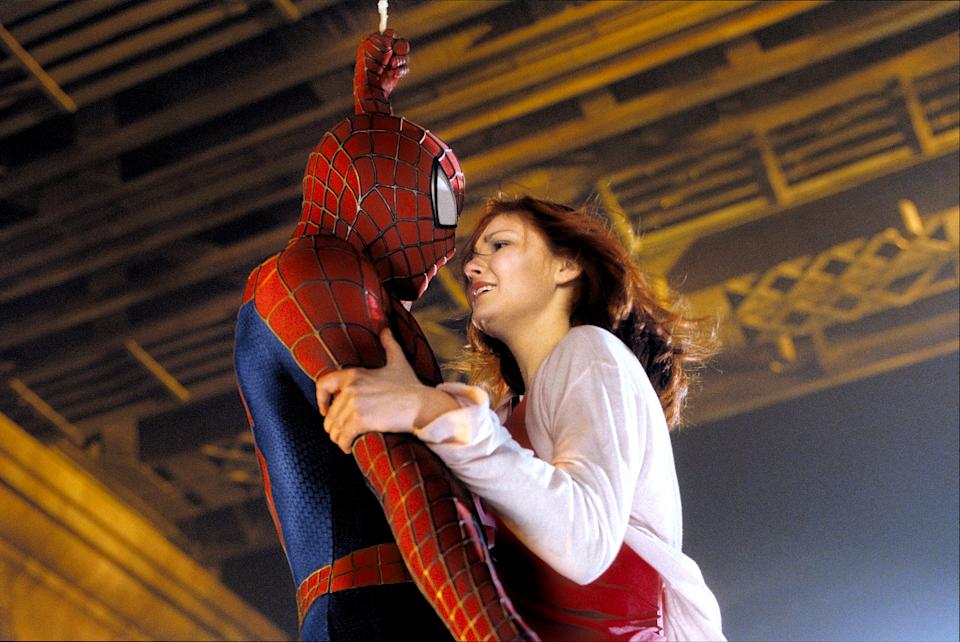The first Spider-Man movie opened 20 years ago, on May 3, 2002, a time when superhero movies were far from the box-office behemoths they are in 2022.
For every instant comic-based classic like 1978’s Superman and 1989’s Batman in the preceding decades, there were myriad misses like Flash Gordon (1980), Howard the Duck (1986), The Shadow (1994), The Phantom (1996) and Steel (1997), not to mention several much-maligned Man of Steel and Caped Crusader sequels.
“For a long time there were movies that failed,” Sam Raimi told us while promoting Marvel’s latest surefire hit, Doctor Strange in the Multiverse of Madness.
Raimi, still in the throes of his horror cult classic Evil Dead trilogy at the time, had unsuccessfully tried to obtain the rights to both Batman and the Shadow. Instead he made 1990’s brooding Liam Neeson-starring Darkman, an $18 million superhero-monster-movie mashup that was well-received but performed only modestly in ticket sales.
In the year 2000, though, everything changed. Just days beyond the turn of the century, Raimi was hired to direct Spider-Man after Sony originally considered such filmmakers as Burton, David Fincher, Chris Columbus, Michael Bay and M. Night Shyamalan. When Fox’s Marvel ensemble X-Men opened to excellent reviews and hefty box-office receipts that July, the blueprint for contemporary comic-book movie franchises was established.
The cinematic Spidey swung into theaters starring Tobey Maguire as everyboy hero Peter Parker in May 2002 with outsized hype — and immediately delivered. Telling the the iconic comic origin story and co-starring Kirsten Dunst as love interest Mary Jane Watson and Willem Dafoe as the villainous Green Goblin, Spider-Man impressed critics, awed fans and registered $403 million at the U.S. box office (and $821 million worldwide). The film’s domestic gross wasn’t just the highest of the year, it bested major franchises Star Wars (Attack of the Clones), Harry Potter (Chamber of Secrets) and Lord of the Rings (The Two Towers) each by a cool $100 million.
The first millennial superhero mega-hit was born.
Today, Raimi credits Sony and Marvel execs Amy Pascal, John Calley, Avi Arad and Matt Tolmach for Spider-Man’s success. “They knew that was going to be a good movie,” he says. “They had the foresight to see that this was really good movie material.”
The blockbuster also arrived at a particularly challenging time in American history.
Spider-Man went into production on Jan. 8, 2001 and wrapped in June, three months before the tragic, world-changing events of 9/11.
[embedded content]
In the film’s first teaser trailer, released that summer in front of films like Jurassic Park III and American Pie 2, a team of bank robbers are shown escaping a heist by helicopter, only to be stopped mid-air and trapped into a giant web. A dramatic pan out reveals the web has been spun in the middle of the World Trade Center’s two massive towers. Likewise, the film’s early teaser poster featured imagery of Spider-Man peering out between New York City skyscrapers, the World Trade Center reflected in his mask eyes.
Sony scrapped such imagery after terrorists attacked the U.S. and destroyed the towers, killing thousands. (The footage in the trailer was not ever intended to be in the film.) Raimi and team did however have to digitally remove other shots of the Twin Towers from the film.
New York was still reeling from the devastating effects of 9/11 when Spider-Man opened eight months later.
One scene in particular proved cathartic for Big Apple audiences rooting for their favorite Queens-born hero. After Peter narrowly saves Mary Jane and a tram full of kids as they all dangle down from the Queensboro bridge — while New York-accented extras hurl objects at Green Goblin with rallying cries like “You mess with Spidey, you mess with New York” and “You mess with one of us, you mess with all of us” — the web-slinger gets hearty cheers from locals looking on.
[embedded content]
Crowds inside New York City movie theaters cheered, too.
Spidey had rebounded to save the day, and New York could come back stronger than ever, too.
Raimi modestly acknowledges the scene may have helped the city heal.
“In its own tiny little way, the way escapist entertainment can take us away from our problems, I thought that Spider-Man tried its part to take New Yorkers away from the horror that was 9/11 [with] brief entertainment,” he says.
Raimi followed up Spider-Man with the even better received Spider-Man 2 (2004), which some still consider the greatest comic-book movie, and the decidedly more mixed Spider-Man 3 (2007).
The director hoped to make a fourth movie, but it never panned out.
“I took a break, I made a horror movie called Drag Me to Hell, and then I was going to go into Spider-Man 4,” he says. “But we couldn’t get the script together in time to make it of excellent quality, so Sony Pictures and I decided to let them go ahead with the reboot and that I would step away.” (Sony eventually rebooted the series, first with Andrew Garfield in The Amazing Spider-Man and The Amazing Spider-Man 2, and then with Tom Holland in Spider-Man: Homecoming, Far From Home and last summer’s No Way Home, which brought together all three Spider-Men.)
A part of Raimi still hopes the story gets told. In fact, he won’t say much about the plot they were conjuring up for a Part 4 in case it ever does.
“We were still working on the script, and that was the problem, we were still trying to figure out the right journey for him to take, but it was the next step in his evolution. I don’t want to say too much in case Marvel or Sony wants to move forward with some version, but it was the next chapter following the story of Tobey Maguire and Kirsten Dunst and the other characters.”
Doctor Strange and the Multiverse of Madness, Raimi’s first superhero movie since Spider-Man 3, opens Friday.




